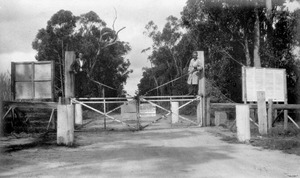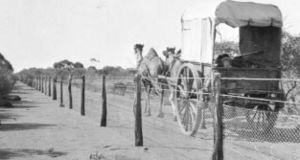Rabbits in Australia facts for kids
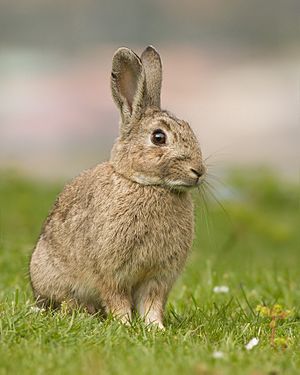
European rabbits (Oryctolagus cuniculus) were brought to Australia in the 1700s. They arrived with the First Fleet, which was the first group of European ships to settle in Australia. These wild rabbits became a huge problem. They are now a serious pest and an invasive species in Australia. This means they are animals that are not native to Australia and cause a lot of harm. Rabbits cause millions of dollars in damage to crops and the environment.
People have tried many ways to control the rabbit population in the 1900s. Some old methods included shooting rabbits and destroying their homes, called warrens. But these methods did not work very well. In 1907, a rabbit-proof fence was built in Western Australia. This fence was meant to stop the rabbits from spreading, but it did not succeed. Later, in the 1950s, a virus called myxoma virus was released. This virus caused a disease called myxomatosis and greatly reduced the number of rabbits. However, the rabbits that survived became stronger and their numbers grew again.
Contents
How Rabbits Came to Australia
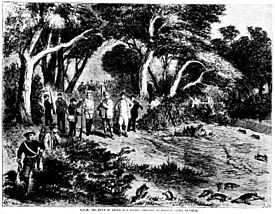
Rabbits first arrived in Australia with the First Fleet in 1788. They were kept in cages for food. For many years, there were not many rabbits. But by 1827, a newspaper in Tasmania said that rabbits were "running about on some large estates by thousands." This shows that rabbits were already spreading quickly in Tasmania.
At the same time, in New South Wales (NSW), people kept rabbits near their homes. They built special areas called "rabbit-warrens" for them. These were like large fenced-in areas. By the 1840s, keeping rabbits became more common. People even started eating them.
The Start of the Big Problem
The huge rabbit problem in Australia seems to have started with Thomas Austin. In October 1859, he released 24 wild rabbits on his property, Barwon Park, near Winchelsea, Victoria. Austin loved hunting rabbits in England. When he moved to Australia, he asked his nephew to send him rabbits so he could keep hunting. He thought "a few rabbits could do little harm."
His nephew sent him a mix of wild and domestic rabbits. One idea is that these different types of rabbits bred together. The new mixed rabbits were very good at surviving in Australia. After Austin, many other farms also let their rabbits go into the wild.
Why Rabbits Spread So Fast
Rabbits are very good at having babies, and they spread quickly across southern Australia. Australia was perfect for them. The winters were mild, so rabbits could breed all year long. Also, a lot of land was cleared for farming. This created huge areas with low plants, which rabbits love.
Within 10 years of Austin releasing his rabbits in 1859, there were so many that two million could be killed each year, but it made no difference. It was the fastest spread of any mammal ever recorded. Today, rabbits are found all over the southern and central parts of Australia.
Even though rabbits are a pest, they helped many people during tough times. During the depressions in the 1890s and 1930s, and during wars, trapping rabbits gave farmers food and extra money. People also fed rabbits to their dogs and chickens. Later, frozen rabbits were sold and sent to other countries. Rabbit skins were used for fur and are still used to make hats.
How Rabbits Harm Australia's Environment
Since rabbits came to Australia, they have caused a lot of damage to the environment. They are thought to be the biggest reason why many native Australian animal and plant species have disappeared.
Rabbits eat a lot of plants. They first eat all the natural grass. Then, they start eating woody plants, like small bushes, and even the leaves and bark of trees. This is called overgrazing. We don't know exactly how many plant species have been lost because of rabbits. But rabbits are known to kill young trees by eating a ring of bark around them.
Rabbits also cause serious erosion problems. When they eat native plants, the topsoil (the rich top layer of soil) is left bare. Then, wind and rain can easily wash or blow the soil away. Losing this topsoil is very bad for the land, as it takes hundreds of years to grow back.
Controlling Rabbit Numbers
By 1887, the damage from rabbits was so bad that the New South Wales government offered a £25,000 reward. They wanted a new way to get rid of rabbits completely. They received 1456 ideas, including some about using diseases. But none of the ideas were found to be both safe and effective.
In 1901, a special investigation called a Royal Commission was held. Once people understood the problem, they tried different ways to control rabbits. These methods did not work very well until new biological methods were used in the second half of the 1900s.
Common Ways to Control Rabbits
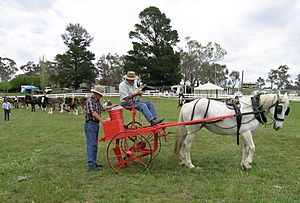
- Shooting: Shooting rabbits is a common method. It can help keep small rabbit populations under control. It also provides food for people or pets. But it does not work for getting rid of large numbers of rabbits.
- Destroying Warrens: Rabbits live in underground homes called warrens or burrows. People destroy these homes by ripping them up with bulldozers, ploughing, blasting, or using gas to fumigate them. This is often done on large farms. The sandy soil in many parts of Australia makes it easy to rip up warrens.
- Poisoning: Poisoning is one of the most common ways to control rabbits. It takes the least effort and can get rid of rabbits in one area. But rabbits from other areas will often move in later. Early poisons used a substance called phosphorus. More modern poisons include "1080" (sodium fluoroacetate) and pindone.
- Hunting with Ferrets: People also hunt rabbits using ferrets. Ferrets chase the rabbits out of their burrows. Then, the rabbits can be shot or caught in nets. This is more of a hunting activity than a way to control large numbers of rabbits.
- Trapping: Trapping was also used often in the past. But steel traps that hurt the rabbits' legs were banned in most states in the 1980s. Trapping still happens, but with traps that are less harmful. These methods only work in certain areas and need a lot of human effort.
Fences to Stop Rabbits
Building fences can create areas that are free of rabbits. In the 1880s, James Moseley fenced off his farm, Coondambo Station. He also fenced off water sources. When a heatwave hit, the rabbits died of thirst. Later, he fenced off other large areas. These fences helped turn land overrun with rabbits into successful sheep farms.
Queensland's Rabbit Fence
In 1884, a politician named Ernest James Stevens suggested that the Queensland Government build a fence. This fence would stop rabbits from New South Wales from spreading into Queensland. In 1893, the Queensland rabbit-proof fence was started. It was extended over the years. In 1997, it was connected to the Dingo Fence. It stretches from Mount Gipps to Goombi.
Western Australia's Rabbit Fence
In 1907, the rabbit-proof fence was built in Western Australia. It stretched between Cape Keraudren and Esperance. The goal was to stop rabbits from the east from moving into farming areas in Western Australia. However, rabbits can jump high and dig tunnels. Also, farmers sometimes left gates open. Because of this, the Number 1 Rabbit-Proof Fence did not stop the rabbits. Even so, smaller fences continued to be successful.
Using Diseases to Control Rabbits
Releasing diseases that affect rabbits has helped control their numbers in Australia. But it did not work as quickly as people hoped.
Louis Pasteur, a famous scientist, suggested using a chicken disease to kill rabbits. This idea did not work. But it helped bring the study of tiny living things (microbiology) to Australia.
In 1950, a virus called myxoma virus was purposely released into the rabbit population. This caused the number of rabbits to drop from about 600 million to 100 million. But the remaining rabbits became resistant to the virus. By 1991, their numbers had grown back to 200–300 million.
To fight this, the Commonwealth Scientific and Industrial Research Organisation (CSIRO) tested another virus. This virus causes rabbit haemorrhagic disease (RHD). In 1995, the virus accidentally escaped from a testing area in South Australia. By 1996, it had spread to Victoria, New South Wales, the Northern Territory, and Western Australia. The virus worked better in dry areas. This was because a milder virus in colder, wetter areas made rabbits immune to the stronger RHD virus.
There is a vaccine for RHD for pet rabbits in Australia. But there is no cure for myxomatosis or RHD, and many sick pets have to be put down. In Europe, where rabbits are farmed, they are protected with a special vaccine.
In 2012, a new, very strong type of the RHD virus was found in Spain. In 2017, Australian authorities released this new virus at about 600 places across the country. Pet rabbit owners were told to vaccinate their animals.
In southern Europe, fewer rabbits mean that other endangered animals that eat rabbits, like the Iberian lynx and the Iberian imperial eagle, are in danger. Because of this, using diseases to fight rabbits in Australia is a big concern for animal protection groups in other parts of the world.
Images for kids



